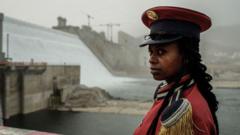Ethiopia has declared the completion of its immense Grand Ethiopian Renaissance Dam (GERD) on the Blue Nile, a development that has long caused friction with downstream neighbors, Egypt and Sudan. Prime Minister Abiy Ahmed shared the news, emphasizing the dam's significance as Africa's largest hydro-electric facility, built with an investment of $4 billion since its inception in 2011.
Ethiopia views the dam as crucial for addressing its energy deficit, asserting that it will produce much-needed electricity for a nation where approximately 60% of the population lacks access to reliable power. Conversely, Egypt and Sudan remain alarmed, worried that the dam might threaten their water supplies from the Nile, a resource vital for both countries’ agricultural and daily needs.
In a statement, Abiy attempted to ease fears, asserting that the Renaissance Dam should be seen as an opportunity for collaboration rather than a threat. He extended an invitation to Egypt and Sudan for the official inauguration scheduled for September, promoting a message of shared resources and hope for constructive engagement.
However, the tension lingers, particularly after a previous warning in 2020 from former US President Donald Trump, who mentioned Egyptian threats against the dam. Recent meetings between Egyptian President Abdel Fattah al-Sisi and Sudan’s military chief, Abdel Fattah al-Burhan, reaffirmed their collective rejection of unilateral actions in managing the Blue Nile Basin.
Despite Ethiopia's commitment to working pragmatically with its neighbors, historical disputes have clouded dialogue efforts, and past negotiations have yet to yield significant breakthroughs. As the dam’s development shifts to the operational phase, regional dynamics remain precarious, with the potential for exacerbating existing tensions over one of the world’s most significant river systems.
Ethiopia views the dam as crucial for addressing its energy deficit, asserting that it will produce much-needed electricity for a nation where approximately 60% of the population lacks access to reliable power. Conversely, Egypt and Sudan remain alarmed, worried that the dam might threaten their water supplies from the Nile, a resource vital for both countries’ agricultural and daily needs.
In a statement, Abiy attempted to ease fears, asserting that the Renaissance Dam should be seen as an opportunity for collaboration rather than a threat. He extended an invitation to Egypt and Sudan for the official inauguration scheduled for September, promoting a message of shared resources and hope for constructive engagement.
However, the tension lingers, particularly after a previous warning in 2020 from former US President Donald Trump, who mentioned Egyptian threats against the dam. Recent meetings between Egyptian President Abdel Fattah al-Sisi and Sudan’s military chief, Abdel Fattah al-Burhan, reaffirmed their collective rejection of unilateral actions in managing the Blue Nile Basin.
Despite Ethiopia's commitment to working pragmatically with its neighbors, historical disputes have clouded dialogue efforts, and past negotiations have yet to yield significant breakthroughs. As the dam’s development shifts to the operational phase, regional dynamics remain precarious, with the potential for exacerbating existing tensions over one of the world’s most significant river systems.



















